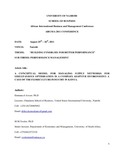| dc.contributor.author | Awuor, Emmanuel | |
| dc.contributor.author | Vosloo, M.M. | |
| dc.date.accessioned | 2013-02-14T09:47:38Z | |
| dc.date.available | 2013-02-14T09:47:38Z | |
| dc.date.issued | 25-08-11 | |
| dc.identifier.uri | http://hdl.handle.net/11295/9860 | |
| dc.description | A CONCEPTUAL MODEL FOR MANAGING SUPPLY NETWORKS FOR SIMULTANEOUS OPTIMIZATION IN A COMPLEX ADAPTIVE ENVIRONMENT: A CASE OF THE FLORICULTURE INDUSTRY IN KENYA. | en |
| dc.description.abstract | This paper is based on research findings and results to develop a conceptual model for
managing supply networks for simultaneous optimisation. The study was a blend of both
quantitative and qualitative research techniques. The qualitative research process made use of
content analysis and was instrumental in answering the following research questions: what are
the key success factors that influence performance of the floriculture industry in Kenya?, what
are the relationships between the key success factors that influence the performance of the
floriculture industry in Kenya? what are the factors that will indicate performance of the
floriculture industry from a traditional perspective (supplier – customer)?, are there differences
in factors to be considered for the embedded and free agents performance in the floriculture
industry, end to end and within country?, what needs to be considered in developing a
conceptual model for simultaneous optimisation of supply networks, end to end and within
country? The quantitative phase of the research process resulted in the development of a revised
conceptual model for managing supply networks for simultaneous optimisation, end to end and
within country.
The flower industry in Kenya is composed of a diverse group, ranging from large scale
international firms to SME’s and free agents. Existing data from Horticultural Crops
Development Authority reveals that there are 412 active flower exporters of which the majority
are SME’s at 358, the large firms are composed of 5 international, 42 National firms and 7 free
agents. The industry is largely affected by changes in customer preferences and demand from the
downstream end of the supply chain. This diversity makes it very difficult to achieve
simultaneous optimization of supply networks with a view to having both individual firm’s
benefits as well as country specific benefits with regard to the triple bottom line. The specific
challenges exhibited by the flower industry which further compounds its complex dimension
includes: extremely short shelf life; Very specific demand cycles with extreme peaks; changes in
consumer trends; mixing characteristics of service and product dimensions; operating part of
‘first world’ supply network in developing country; a composition of large , small international
and free agents operating in the industry and; simultaneous optimization of supply networks in
an effort to realize both individual firm’s benefits as well as country specific benefits.
The paper concludes by identifying a set of issues that needs to be addressed by both the Kenyan
government and flower firms. These issues includes but are not limited to: developing consensus
over a complex adaptive system and a complex adaptive environment with regard to the flower
industry in Kenya; identifying the characteristics of a complex adaptive systems; and
establishing methods of managing complex adaptive systems with reference to the flower
industry. The findings and results of the study points at: financing; key success factors (supply
value chain); country specific benefits; transport; research and development as positively
influencing the performance of the floriculture industry in Kenya. | en |
| dc.language.iso | en | en |
| dc.subject | Complex adaptive systems | en |
| dc.subject | Complex adaptive environment | en |
| dc.subject | Simultaneous optimisation | en |
| dc.subject | Managing Supply Networks | en |
| dc.title | A CONCEPTUAL MODEL FOR MANAGING SUPPLY NETWORKS FOR SIMULTANEOUS OPTIMISATION IN A COMPLEX ADAPTIVE ENVIRONMENT | en |
| dc.title.alternative | A CASE OF THE FLORICULTURE INDUSTRY IN KENYA. | en |
| dc.type | Other | en |

